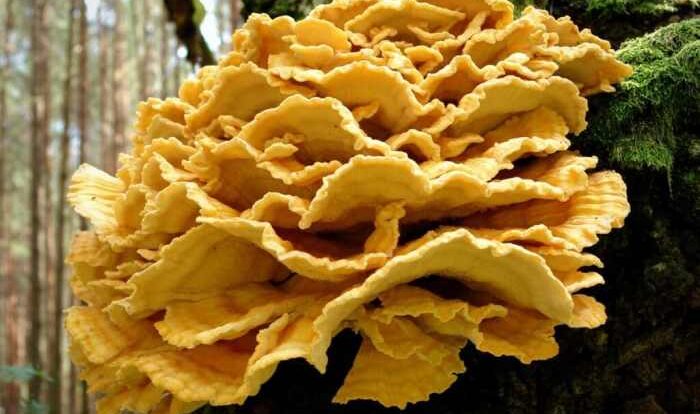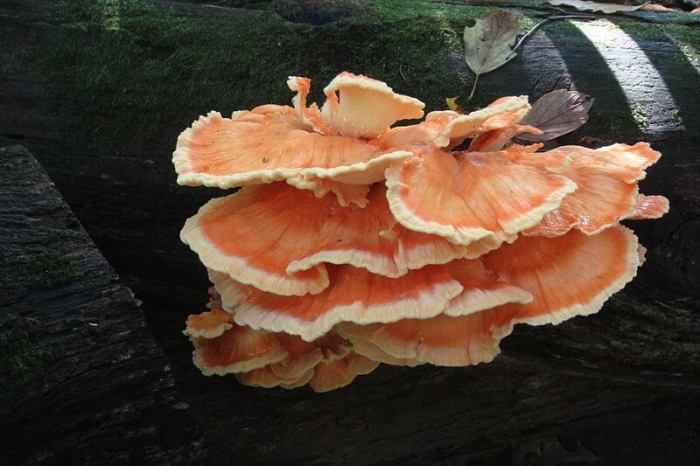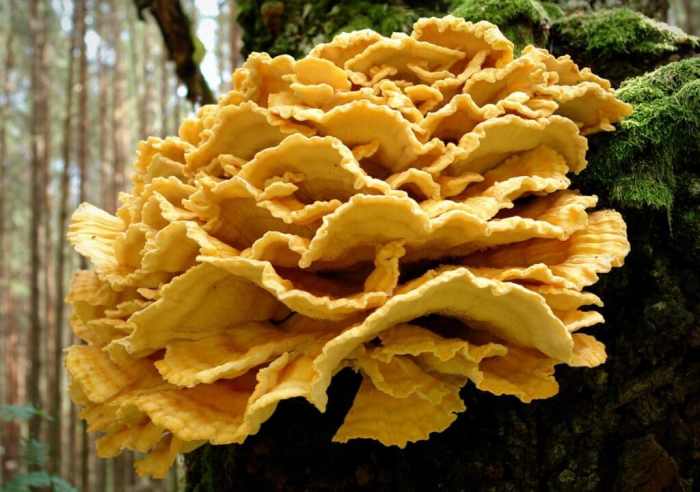
Chicken of the woods recipe, an edible mushroom that resembles chicken in texture and flavor, offers a unique culinary experience. In this guide, we will explore the various cooking methods, health benefits, identification techniques, and preservation tips for this versatile ingredient, inspiring you to incorporate it into your culinary repertoire.
Recipe Options: Chicken Of The Woods Recipe
Chicken of the woods is a versatile mushroom that can be prepared in a variety of ways. Traditional recipes often call for sautéing or roasting the mushrooms, while modern variations may include grilling, baking, or even using the mushrooms in soups and stews.
The flavor of chicken of the woods is mild and slightly nutty, making it a good choice for a variety of dishes. It can be seasoned with a variety of herbs and spices, and it pairs well with both light and hearty sauces.
Sautéing
Sautéing is a quick and easy way to cook chicken of the woods. Simply heat some oil in a pan and add the mushrooms. Cook over medium heat until the mushrooms are browned and tender.
Roasting
Roasting is another great way to cook chicken of the woods. Preheat your oven to 400 degrees Fahrenheit. Toss the mushrooms with some olive oil, salt, and pepper, and then spread them on a baking sheet. Roast for 20-25 minutes, or until the mushrooms are browned and tender.
Grilling
Grilling is a great way to add a smoky flavor to chicken of the woods. Preheat your grill to medium-high heat. Brush the mushrooms with some olive oil and then grill for 5-7 minutes per side, or until the mushrooms are browned and tender.
Nutritional Value and Health Benefits

Chicken of the woods is a nutritional powerhouse, offering an array of essential nutrients. It’s a rich source of protein, providing about 10 grams per 100-gram serving, making it a great option for vegetarians and vegans looking to increase their protein intake.
Furthermore, chicken of the woods is a good source of dietary fiber, which aids in digestion and promotes satiety. It’s also packed with vitamins, including vitamin C, vitamin D, and B vitamins, which are crucial for various bodily functions.
Immune System Support
Chicken of the woods contains compounds that have been shown to support the immune system. Studies have suggested that it may enhance the production of white blood cells, which play a vital role in fighting off infections.
Anti-inflammatory Properties
Chicken of the woods possesses anti-inflammatory properties that may help reduce inflammation throughout the body. This can be beneficial for individuals with conditions such as arthritis, asthma, and inflammatory bowel disease.
Incorporating Chicken of the Woods into Your Diet
Adding chicken of the woods to your diet is a simple way to boost your nutrient intake and promote overall well-being. It can be enjoyed in various ways, including:
- Sautéed with garlic and herbs
- Grilled as a vegetarian steak
- Added to soups, stews, and casseroles
Identification and Foraging Techniques

Chicken of the woods is a distinctive mushroom that stands out with its vibrant orange to yellow coloration and unique shape. Typically found growing in clusters on the sides of trees or stumps, it prefers hardwood varieties like oak, maple, and beech.
Its seasonal availability spans from late summer to early fall, making it a prized find for foragers.
Identification
Identifying chicken of the woods involves observing its key characteristics:
-
-*Color
Hey, have you tried the chicken of the woods recipe ? It’s a wild mushroom that’s supposedly similar to chicken in taste and texture. I’ve been curious to try it myself.
Ranges from bright orange to golden yellow, often with a hint of red or pink
-*Shape
Irregular and shelf-like, with multiple overlapping layers or lobes
-*Size
Can grow quite large, with individual clusters reaching up to 12 inches in diameter
-*Texture
Firm and meaty, with a slightly fibrous texture when cooked
Distinguishing from Similar Species
To avoid confusion with other species, it’s essential to note these distinctions:
-
-*False chicken of the woods (Laetiporus sulphureus)
Similar in appearance but has a sulfurous odor and grows on conifers rather than hardwoods
-*Chicken of the woods lookalike (Polyporus squamosus)
Also grows on hardwoods but has smaller, more rounded pores and a brown or gray coloration
Responsible Foraging, Chicken of the woods recipe
Sustainable foraging practices are crucial for preserving chicken of the woods populations. Here are some guidelines to follow:
-
-*Harvest only mature specimens
Allow smaller ones to grow and reproduce
-*Leave the base intact
Cutting the mushroom flush with the tree damages the mycelium and reduces future growth
-*Respect the environment
Avoid disturbing the surrounding vegetation and wildlife
Culinary Applications

Chicken of the woods is a versatile culinary ingredient that can be used in a wide variety of dishes. Its meaty texture and savory flavor make it a popular choice for soups, stews, salads, and pasta dishes.
Chicken of the woods can be cooked in a variety of ways, including sautéing, roasting, grilling, and frying. It can also be used to make vegetarian “chicken” stock or broth.
Soups and Stews
Chicken of the woods is a great addition to soups and stews. It adds a meaty texture and savory flavor to the dish. Chicken of the woods can be used in any type of soup or stew, but it is especially good in hearty soups and stews with a lot of vegetables.
Salads
Chicken of the woods can also be used in salads. It adds a meaty texture and savory flavor to the salad. Chicken of the woods can be used in any type of salad, but it is especially good in salads with a lot of greens and vegetables.
Pasta Dishes
Chicken of the woods can also be used in pasta dishes. It adds a meaty texture and savory flavor to the dish. Chicken of the woods can be used in any type of pasta dish, but it is especially good in pasta dishes with a lot of sauce.
Preservation and Storage

Chicken of the woods can be preserved using various methods to extend its shelf life and maintain its quality. These methods include drying, freezing, and canning.
Drying
Drying is an effective way to preserve chicken of the woods for long-term storage. It removes moisture from the mushroom, inhibiting the growth of microorganisms and preventing spoilage. To dry chicken of the woods, slice it into thin strips and spread it on a drying rack or tray in a well-ventilated area with low humidity.
The drying process can take several days or weeks, depending on the thickness of the slices and the ambient temperature. Once completely dry, store the chicken of the woods in an airtight container in a cool, dry place.
Freezing
Freezing is another method for preserving chicken of the woods. It slows down enzymatic reactions and microbial growth, extending the mushroom’s shelf life. To freeze chicken of the woods, clean and cut it into desired sizes. Blanch the mushrooms in boiling water for 2-3 minutes to deactivate enzymes and preserve texture.
Drain and cool the mushrooms before freezing them in airtight containers or freezer-safe bags. Frozen chicken of the woods can be stored for up to 6 months.
Canning
Canning is a traditional method of preserving chicken of the woods that involves sealing it in airtight jars or cans. This method requires specialized equipment and a pressure cooker to ensure proper sterilization and prevent spoilage. To can chicken of the woods, clean and cut it into pieces.
Pack the mushrooms into jars or cans, leaving about 1 inch of headspace at the top. Add a canning solution made with water, salt, and vinegar. Process the jars or cans in a pressure cooker according to the manufacturer’s instructions.
Canned chicken of the woods can be stored for up to a year in a cool, dark place.
Storage
Proper storage is crucial to maintain the freshness and quality of chicken of the woods. Fresh chicken of the woods should be stored in a paper bag or breathable container in the refrigerator. It should be consumed within a few days of harvesting to prevent spoilage.
Dried chicken of the woods can be stored in an airtight container in a cool, dry place for several months. Frozen chicken of the woods should be stored in airtight containers or freezer-safe bags in the freezer for up to 6 months.
Canned chicken of the woods can be stored in a cool, dark place for up to a year.
Conclusive Thoughts

Whether you’re a seasoned forager or a curious home cook, this comprehensive guide to chicken of the woods recipe will equip you with the knowledge and inspiration to enjoy this wild mushroom’s unique flavors and nutritional benefits.
General Inquiries
Is chicken of the woods safe to eat?
Yes, chicken of the woods is generally safe to eat when properly identified and cooked. However, it’s always advisable to consult with a mushroom expert or refer to reliable field guides before consuming any wild mushrooms.
How can I identify chicken of the woods?
Chicken of the woods is characterized by its bright orange to yellow coloration, shelf-like shape, and meaty texture. It typically grows on the trunks or stumps of oak trees in late summer and fall.
What are the health benefits of chicken of the woods?
Chicken of the woods is a good source of protein, fiber, and antioxidants. It has also been shown to have anti-inflammatory and immune-boosting properties.





